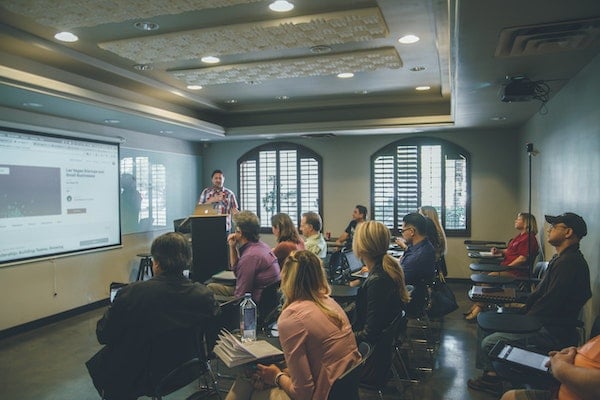Published on
Developing Programming for Nontraditional Learners at Community Colleges

Traditionally, higher ed has been very slow to change. But in today’s environment, it’s especially important for institutions to be agile and adapt quickly to the ever-evolving needs of the workforce. Community colleges are the gateway to providing relevant and adaptive programming to the lifelong learner that will keep them competitive in the workforce. In this interview, Scott Silverman discusses the challenges with developing nontraditional programming at community colleges, why continuing ed divisions need to be nimble and agile, and the myths that surround non-degree education and Workforce Development.
The EvoLLLution (Evo): What are some of the key obstacles to developing programs and support services for nontraditional and noncredit learners at community colleges?
Scott Silverman (SS): Honestly, the biggest challenge that we have is that there are ever-changing needs, and institutions of higher learning are generally not agile. We don’t respond quickly in many cases. So, the needs are going to evolve faster as we go, and we need to find ways to respond more nimbly.
Typically, the workforce and noncredit programs both tend to be quicker at this than the credit programs. But in my experience, trying to figure out whether a program should be noncredit, credit or a true workforce program—which is somewhere in between—can be tricky. So, it’s finding ways to be nimble. And right now, we’re looking at all the problems we’re going to experience post –COVID—all the job losses that we don’t have a solid grasp on yet, as well as how the workforce has changed. We’re going to need to evolve more and more quickly every year. We have to find a way to respond to those changing needs, especially those of students, who are, perhaps, demanding different things than they would have before.
Evo: What are some of the drivers for continuing ed divisions to be agile, nimble and market-responsive?
SS: Part of it is that there tends to be more funding readily available for program development on our side of the house. To some extent, credit programs have a much more longitudinally driven process for curricular development. Maybe it’s a lot more prescribed, which is good in many respects. But there’s a viscosity there, a thickness that slows the process down. And I don’t think there is a right way—we need both. We need this multifaceted, multi-pronged approach to really educate the workforce.
I worked mostly at four-year schools. Most of higher education has focused on a single goal: the bachelor’s degree. And that just isn’t appropriate. We know that in the community college setting, people are looking for AAs, certificates or just a class here and there to upskill and get back in the workforce. I wish I could go back and tell myself this 20 years ago, that we’re really going to have to think about what the student experience is, what students’ needs are in a long-term sense.
Within my own institution, how do we use noncredit as a catchall for students who stop and drop out. How do we use noncredit to retain them? Maybe they don’t need to re-matriculate into an AA program, maybe they want to or maybe they just want to take a class or two, which means it’s far easier for the district to re-enroll them and re-matriculate them into a credit program later, if we haven’t completely abandoned or lost them. I’m sure a lot of schools are doing this. It’s cheaper to retain the students than it is to recruit new ones. And it’s better for the student and for the school. We’re starting to see some groundswell locally from people on the credit side, who never touched noncredit before, who are resonating with our messaging that noncredit is a viable option for our students. It’s a viable pathway for student upward mobility.
Evo: What are the obstacles that keep the relationship between continuing ed divisions and main campus from forming?
SS: The program I was running before was a noncredit program, but it was really focused on older adults—senior citizens. Even then there was concern about whether it would detract from enrollment on the credit side, but I found no overlap there. On noncredit, there is that concern about bleeding away from credit enrollment, which pays more from the state and from the student. Is there a benefit to that? I’m not sure if that’s all of it. Part of it might be some element of control.
Do the credit programs get to govern what’s taught in every noncredit workforce area? And then of course, depending on how programs are set up and structured, certainly there’s the curricular approval process. But between you, me and the Zoom walls, I don’t know that a credit faculty is going to lose sleep about what I’m teaching to the emeritus older adult students. I don’t think they should. The students take the same classes every year until they can’t come to campus anymore—literally, the same class for ten years on end—and it becomes like a senior center in many respects. Now, the rest of noncredit and workforce have a different dynamic, a different demographic–much younger, still working or hoping to work.
When you have a program that’s noncredit, does that program ever become a credit program? If you have a noncredit HVAC certification program, when does it make fiscal sense for the college to make it a credit program instead? And if it makes fiscal sense for the college, does it then make the same sense for the student? I don’t know how it works in every other state, but in California, community college noncredit classes don’t cost the student a dime. If we’re raising the cost to make it a credit program, does it really make that much more sense for that student’s career trajectory to have a credit program versus a noncredit certificate? I don’t know if that’s necessarily the case. But few people have really thought globally about how to intersect all the programs in a really nice fashion.
We have metrics for all these achievement outcomes, to help the student get something done, that hopefully make them more successful. What can we give them that helps them in their career or just in their overall life skills goals, that meets our metrics, and that keeps them tied to the district, so that they hopefully re-enroll?
Evo: What are some of the other significant opportunities you’re seeing on the horizon for Workforce Development to continuing at divisions of community colleges?
SS: There’s a lot of opportunity. The biggest challenge is we don’t even know all the opportunities that exist—the sky’s the limit. There’s talk about how to tap into emerging fields. And noncredit workforce can leverage that opportunity a lot faster than credit can, depending of course on regulations and course approval. There’s some talk on the West Coast about the ocean economy—all the new fields and disciplines that we’re going to see emerge out of deeper oceanographic research. We’ve only tapped into like 5% of resources in the ocean, but we have to do it in a sustainable way that also leverages resources and scaffolds out entirely new industries.
I’ve been involved in a few very tangential conversations about this, but there’s huge potential there. Thinking about how the workforce is going to change, given the fact that so many people have worked from home for the last year, what’s going to emerge from that? There are tons and tons of pockets of new things that could evolve out of this. I just don’t know the grand scope of it.
Even my wife and I were talking about how businesses are going to form sort of on the side, like side hustles that people have been working on or thinking about these last 15 months. It’s either going to be opportunities for us to leverage or obstacles for us to try to enroll students in, when they’re going to be doing all these other competing interests.
Evo: How do you leverage existing expertise while also understanding the needs of the demographic that you’re serving?
SS: The number of course offerings that are now digital, that might remain so beyond COVID, has totally upended lots of college planning. So, the competition for hybrid and online courses is steep. In California, for example, Calbright was the new community college built by the chancellor’s office for online community college, but now we’re all doing that sort of stuff. So, there are questions about doing this statewide initiative. Not competing with each other but still doing things that are unique and serve students’ interests. At the same time, everyone everywhere is doing really robust online education stuff, not through a community college, not through an accredited body. How do we compete against all of these new players?
A ton of free resources are provided by industry, and it doesn’t make sense for us to compete in that same way. So, there’s opportunity, but to figure out a way to do it while meeting our minimum enrollment targets for the program to be viable is going to be challenging.
Evo: What are the most common myths that you’ve seen when it comes to what the main campus administration tends to think about the work done by non-degree and Workforce Development?
SS: One of the biggest myths is that noncredit and workforce students are a separate entity, and that’s not really the case. They’re still our college’s students. They’re our college’s students taking noncredit classes, and a lot of them are actually credit students, too, taking some noncredit classes. There’s so much back and forth between the programs and if there isn’t, there should be. It’s a mutual intersection of the programs or students that flow from noncredit to credit or vice versa. They’re part of the whole community college environment. I’ll be honest, I’m not sure I fully realized it until one of my staff members said that to me. And I said, “Oh, you’re totally right.” We could do some of the same student services wraparound programs and school spirit, which I know is a little bit less in a community college setting than in a four-year school, but some of that same stuff could still apply. How do we get our noncredit students to not feel as though they’re less than the credit students? And more importantly, how do we make sure that our colleagues across campus don’t think of them that way? Generally, they bring less to the bottom dollar, but they still are a vital component to what we’re doing.
There’s some benefit to thinking about whether the institution does any fundraising foundation work with the noncredit students. At my college, the older adult students in the emeritus program are probably the single biggest donor group on campus, which makes sense because they built wealth over an entire career. And if you look at them compared to every other donor group put together, they’re still larger than all the other donations put together.
Now, the average noncredit student taking classes to up-skill and get a job is not going to give any gifts right then and there. But I bet if we look long term at what kind of fundraising we can do and what connections we can make to support the district, some of the biggest donors nationwide probably come from these ancillary, noncredit experiences. Long-term connection adds the affinity that is built up over time. They’re constantly coming back to do more upscaling or just take classes for fun. And there’s better opportunity to engage them again because they’re local.
Evo: Why are organizations like NCCET so important to the growth of Continuing Ed and community colleges?
SS: I’m relatively new to broad noncredit, but NCCET and professional associations in general helps all of us learn from each other. A lot of us have statewide entities that we go to, or maybe they’re locally just tied to our district or region, but NCCET as a national organization really enables us to learn from and leverage each other. I probably shouldn’t develop a program that a school 20 minutes away has, but I can learn from a school across the country, maybe adapt parts of their program and have a unique service program that serves my area in a broadly without having to worry about the competition.
There are benefits to learning from each other because I might find a colleague at a conference who is where I was maybe five or ten years ago, and I can learn from them and their experiences. And at the same time, I bring certain skills to the table. There’s experience I have with fundraising efforts that I can offer colleagues.
It’s interesting to think about—this emeritus program. I cannot spend the money fast enough, but it’s built that way so that if the state ever decided to cut funding for the emeritus program, we’d have money to carry us through a couple of years while we figure out a new plan. It’s this rainy day fund the students have created over the last 45 years, which is amazing. When we want to put in automatic doors for bathrooms this summer and changed the main entry door to the classroom, when it’s not required by ADA, we can afford it. Now, that’s a very unique position. Very few programs have that kind of foundation and support that’s built up over time.
I’ve always been involved in many organizations, and the true benefit is leveraging each other’s resources and experiences. Because even though you want to give credit to programs when you adapt different things, really the professional associations are an opportunity to borrow and share. I can’t serve everyone through my programs, but if I can help someone else make their program better, and I can use their experience to make my program better. That’s amazing. That’s what NCCET can do.
This interview was edited for length and clarity.
Disclaimer: Embedded links in articles don’t represent author endorsement, but aim to provide readers with additional context and service.



